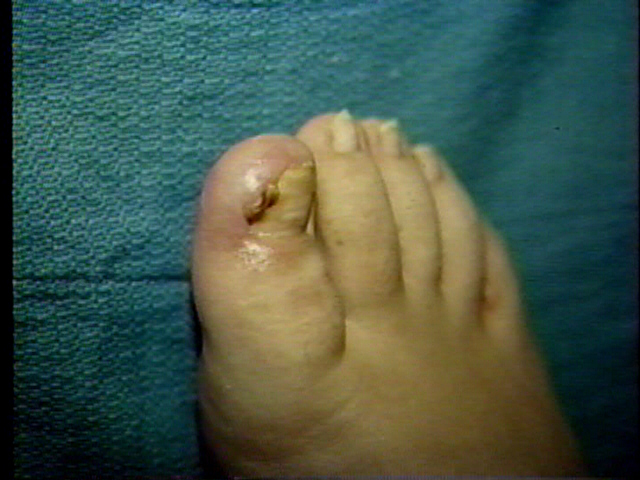Ingrown toenail
This condition usually presents with
erythema, edema, a crusted drainage, and pain along the affected nail
border. Usually the etiology involves trauma, a diseased nail,
ill-fitting footgear, or injudicious cutting of the nail.
Treatment
A digital block is obtained with 3 to 5cc of 1%
lidocaine and a 25 or 27 gauge 1 1/4 inch needle at the proximal
portion of the toe making sure to address all four nerves (dorsomedial,
plantar medial, dorso-lateral, and plantar-lateral). Once anesthesia
is achieved, prep the toe with betadine and remove approximately 1/8th
of the offending nail border. Using a thin instrument, slide under the
offending nail border from distal to proximal. With the same
instrument detach the dorsal part of the nail from the proximal toe
tissue fold. With iris scissors, cut the detached 1/8th of the nail
boarder from distal to proximal making sure to cut the nail under the
proximal toe tissue fold, then roll the detached nail out with a
hemostat.
Have the patient soak in warm water
twice a day for 1 or 2 days. Post nail removal pain relief can be
achieved with
NSAIDs. The patient may need a day or two of no marching. If an
ingrown toenail is a chronic problem (three or more removals from the
same side) the patient may be referred to podiatry for permanent
removal. The majority of patients will not need antibiotics. This
condition may be perceived as a foreign body reaction. When the
foreign body (the nail) is removed the problem is solved.
Corns and
Calluses
Corns and calluses are specific
accumulations of stratum corneum over bony prominences. Corns most
often occur on the dorsal aspect of hammer toes. Calluses usually
appear plantar near the metatarsal heads. Corns and callus are the
reaction of normal skin to an abnormal amount of intermittent friction
and pressure. They can be quite tender and can interfere with work as
well as off duty activity. Calluses are often misdiagnosed as planter
warts. Plantar warts have pinpoint spots of punctate bleeding on
debridement while calluses are free of bleeding during debridement.
Treatment
The treatment for corns and calluses are focused at decreasing the
skin build up and reducing the friction and pressure from the affected
area(s). Debride the excess skin with a 10 or 15 blade. Corns are best
treated after debridement with a larger, wider shoe and a moleskin
appeture pad with a cut out area over the lesion. A callus is treated
with debridement along with the placement of a Spenco® insole into the
work shoe. Spenco® insoles are carried by most military exchanges.
Discourage the use of medicated pads
or liquid corn removers since these treatments can cause ulceration. A
routine consult to podiatry is appropriate when the patient is on
shore duty and wishes more aggressive treatment.
Plantar Foot Laceration
Treatment
Flush the wound with 1%
lidocaine containing 1:100,000
epinephrine. Inspect the wound for any foreign bodies. Copiously
flush the wound with sterile water from a 10 cc syringe until all
debris is washed or picked out. If the wound is clean and 6 hours old
or less, anesthetize the area and close with 3-0 or 4-0 nylon sutures.
If the wound is old or dirty lightly pack it open with moist Nu-gauze.
Dress the wound with nonadherent gauze, gauze fluff, and roller gauze
(kling). Keep patient's foot elevated for 2 days and keep patient
non-weight bearing on crutches for 2 weeks. If the wound is healed,
sutures can be removed after 2 weeks. Unremovable foreign bodies in
the foot should be referred to podiatry.
Heel Spur Syndrome
and Plantar Fasciitis
Heel spur syndrome and planter
fasciitis are similar conditions on the plantar aspect of the foot.
Both conditions involve the structure known as the planter fascia.
Heel spur syndrome presents with pain on the plantar medial side of
the heel and is usually presents as pain during the "first step in the
morning." Plantar Fasciitis can present as tenderness throughout the
arch with pain also experienced as the "first step in the morning".
However, pain is experienced usually later in the day during
exercising or other daily activities. Both heel spur syndrome and
plantar fasciitis are overuse-related conditions. These can be
secondary to foot type, life style (Marine) or overweight body
habitus.
Treatment
Have the patient buy an over the counter arch support such as the
Spenco -Walker Runner® or Sorbathain® arch support. Medications should
include
NSAIDs. Educate the patient in stretching the plantar facie twice
a day by dorsiflexing the foot, dorsiflexing their toes, and massaging
the planter fascia with their other hand. The patient may also massage
the planter fascia with ice. Place the patient on about 30 days light
duty. If pain persists for more than one month inject the point of max
tenderness with a 1:1:1 mix of 1% lidocaine without epinephrine + 0.5%
marcaine without epinephrine + kenalog 10, 3cc total. If pain
continues for more than 2 months referral to podiatry or physical
therapy is recommended.

